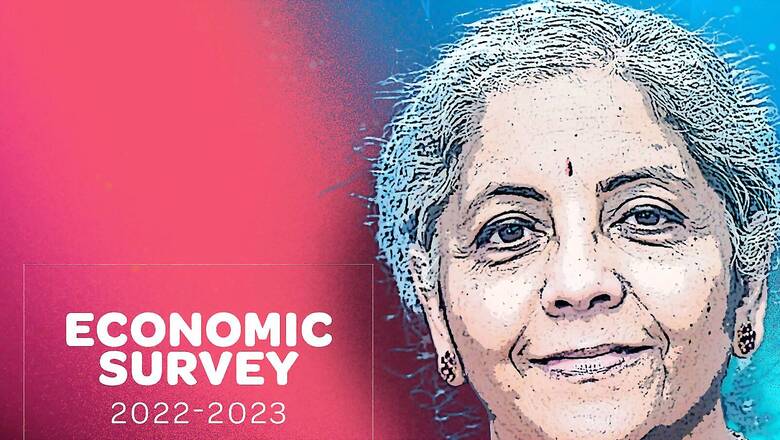
views
India’s Finance Minister Nirmala Sitharaman today, a short while after the first address of President Draupadi Murmu, to the joint session of the Parliament, presented her fifth Economic Survey, ahead of her last full Union Budget of the present government to be presented in the Lok Sabha, on February 1.
This year, the Economic Survey comes amidst a year of trials and tribulations, twists and turns in the global societal, economic and geopolitical uncertainties, at a time when the world and India had just begun living in the new-normal world after two years of unprecedented battering owing to the onslaught of the chaos and confusion caused by Covid-19 pandemic and the latest invasion of Ukraine by Russia.
The 414 pages 12-chapter long sprawling Economic Survey takes a comprehensive take on the Gestalt of the nation’s state of the economy, its medium-term growth, fiscal and monetary big picture, prices and the war against inflation, state of the social infrastructure and the big challenge of employment, the climate change and the environment challenge, agriculture, food management and food security, industry and services, external sector and finally the core infrastructure – physical and digital.
The survey rightly notes that despite the extraordinarily global scenario, the year 2022 has proved special for India. It has been the year when the country celebrated its 75th year of Independence and the Indian economy, after catapulting to the fifth position globally, (dethroning Britain) find it at the threshold of being at US$ 3.5 trillion, moving fast forwards on the path to becoming the fourth largest economy.
Here are the following 13 takes on India, today, that emanate from the Economic Survey both headwinds and tailwinds as the country moves on the path to be a developed nation by 2047 when it celebrates hundred years of independence.
- Despite the hard landing of the economy after its encounter with Covid, it achieved full recovery in FY2022 and is ascending to actualise the pre-pandemic state of the economy in FY2023. The growth rate of the economy by global institutions is paged between 6.5-7 percent in FY23, while the Survey presents an optimistic growth scenario of 7 percent for FY2023. Even if the growth is in the lower band around 6-6.5 percent, then also, the growth of the Indian economy will be the highest globally. The Indian economy, being on the growth trajectory by its broad decoupling, is largely owing to four factors- first, the resilience of private consumption, second, the Capital Expenditure of the Central government which was up 63.4 percent in the first eight months of FY23, third the Capex by the Corporate sector which, according to one research, increased to Rs 3.3 lakh crore in H1 of FY23, driven by heavy investments in electricity, steel, chemicals, and pharmaceuticals sectors and finally uptick in private sector consumption. Even though global growth has been projected to decline in 2023, the Indian economy is still likely to grow at 6.5 percent– highest in the world turbocharged by tailwinds of increasing private consumption and capital formation.
- Both due to external and internal reasons, but led by the external factors, the country’s retail inflation leapt above the RBI’s tolerance range in January 2022 and persisted above the target range for 10 months before returning below the upper end of the target range of 6 percent in November 2022. Nonetheless, the inflation outlook remains uncertain and unpredictable and a major headwind to the actualisation of the growth potential.
- After chaotic two years, India’s exports had robust growth in 2022–16 percent in the first nine months of the current financial year–when compared to the same period of FY2022. However, the policy of global central banks’ aggressive and synchronised monetary tightening, the war situation and China problems, the global economic growth has slowed down and is likely to impact the export front in FY2024.
- The Survey presents a better picture of finances of the public sector banks (PSBs), which have shown a significant turnaround, both with regard to increasing profits and reducing Non-Performing Assets (NPAs) fast-tracked with the quicker resolution/liquidation by the Insolvency and Bankruptcy Board of India (IBBI) and periodic capitalisation of PSBs by the government, thereby ensuring the desired level of Capital Risk-Weighted Adjusted Ratio (CRAR).
- The Survey puts primacy on the health of the farm sector, which is critical for the economic and social well-being of the country and focuses on the big picture of how the country has achieved domestic food security, catapulted into a net exporter of farm output to the world and is now transitioning from the food security to the nutritional security at a faster pace.
- Inclusive growth and employment generation – The survey stipulates that the growth being achieved is inclusive and one that is creating jobs and to prove its point, it uses an increase in employment level, using both official and unofficial numbers. It takes a cue from the Periodic Labour Force Survey (PLFS) to establish that the urban unemployment rate for people aged 15 years and above has declined from 9.8 percent in the quarter ending September 2021 to 7.2 percent one year later, accompanied by an improvement in the labour force participation rate (LFPR), confirming the emergence of the economy out of the pandemic-induced slowdown early in FY23. Nonetheless, stable and sustainable fast job creation in both urban and rural India remains the Achilles’ Heel, a critical task facing the government.
- Medium-term growth – The Survey stipulates that after a long period of balance sheet repair of the financial and corporate sector, the country’s financial cycle is poised to start its journey on an upward trajectory. Also, with the health and economic shocks of the pandemic and the spike in commodity prices in 2022 tapering off, the Indian economy is well placed to grow at its potential in the coming decade, similar to the growth experience of the economy after 2003. The Survey boldly predicts a high growth rate in years to come- 6.5 percent real GDP growth in the medium term without reforms and if mandated reforms in the survey are unleashed, then achieving GDP growth at 7-8 percent per annum is inevitable.
- Buoyant revenues despite fiscal pressures of an uncertain macro-economic environment aggravated by war in Europe and dismantling of the global supply chain and high prices of commodities, fuel and food, the country is on track to keep the fiscal deficit within the budget estimate of FY23, turbocharged by the recovery in economic activity, buoyancy in revenues from direct taxes and GST, with the gross revenue showing YoY growth of 15.5 percent from April to November 2022, driven by robust growth in both direct taxes and Goods and Services Tax (GST). Despite uncertain times, the fiscal deficit of the Central government was 9.2 percent of GDP during the pandemic year FY21, moderated to 6.7 percent of GDP in FY22 PA and is expected to be 6.4 percent of GDP in FY23. In line with the fiscal glide path envisioned by the government is a result of careful fiscal management supported by buoyant revenue collection over the last two years.
- Capex- On the expenditure side, the Union government’s emphasis on capital expenditure (Capex) has continued despite higher revenue expenditure requirements during FY2023. Steadily, the Capex has increased from a long-term average of 1.7 percent of GDP (FY09 to FY20) to 2.5 percent of GDP in FY22. More importantly, the Centre off late has incentivised the state governments through interest-free loans and enhanced borrowing ceilings to prioritise their spending on Capex. With an emphasis on infrastructure-intensive sectors like roads and highways, railways, and housing and urban affairs, the increase in Capex has large-scale positive implications for medium-term growth. The Capex-led growth strategy is expected to enable India to keep the growth interest rate differential positive, leading to a Capex-led growth, leading to sustainable government debt to GDP in the medium run.
- The Survey puts high emphasis on climate change and environmental focus through the most robust climate actions through its Nationally Determined Contributions (NDC), including fast transformation to an ambitious clean energy program.
- The Survey has a dominant focus on inclusive and sustainable industrial and services growth, led by both public and private investment, through robust policies that have eased business conditions and improved viability. The survey postulates the bright services sector as a source of strength that is poised to gain more.
- That brings the twelfth and last chapter of the Survey that focuses on infrastructure. As the Survey says ‘last but not the least’ is clichéd, but in this case, it is a truthful cliché. The Survey emphasises that in 2019, the Government of India adopted a forward-looking programmatic approach towards infrastructure. The National Infrastructure Pipeline was born with a projected investment of around Rs 111 lakh crore for FY20-25 for developing a comprehensive view of infrastructure development in the country. Roads, railways, and waterways have seen unprecedented expansion in the last eight years, and ports & airports have been substantially upgraded. Extending infrastructural facilities is only part of the story; modernisation is the other important objective that has been pursued with verve and achieved with commendable speed.
- Finally, the Survey rightly emphasises the growth and evolution of India’s public digital infrastructure as a big-bang success story, not just of numbers and milestones, but also of thoughtful regulatory and innovation architecture that has enabled it to retain its public good character with enough incentives for the private sector to innovate and invest. The Survey rightly emphasises that the untapped potential is huge, and the country needs to continue to innovate. With digital technology and infrastructure, India, i.e. Bharat, has to keep running to hold onto its place.
The Survey rightly touches on India assuming the Presidency of G-20 nations in December 2022. Global problems need global solutions and global solutions require collaboration and cooperation. Based on the theme of ‘Vasudhaiva Kutumbakam: One Earth, One Family, One Future’, India’s G20 Presidency aims to achieve coordinated solutions to key issues of global concern. The Presidency is a platform for India to share its success stories with the global community, especially the manner in which Digital Public Infrastructure has supported an inclusive people-centric growth paradigm. In short, the G20 Presidency is an opportunity for India to bind an otherwise fragmented global order.
Lastly, the Survey– by putting it in the public domain– exhorts cogent thinking, formulation of ideas and their effective articulation.
Akhileshwar Sahay is a Multidisciplinary Thought Leader and India based International Impact Consultant. Sahay works as President, Advisory Services of consulting firm BARSYL. Views in the article are of the author, and do not represent the views of this publication or the organisation where he works.
Read all the Latest Opinions here


















Comments
0 comment